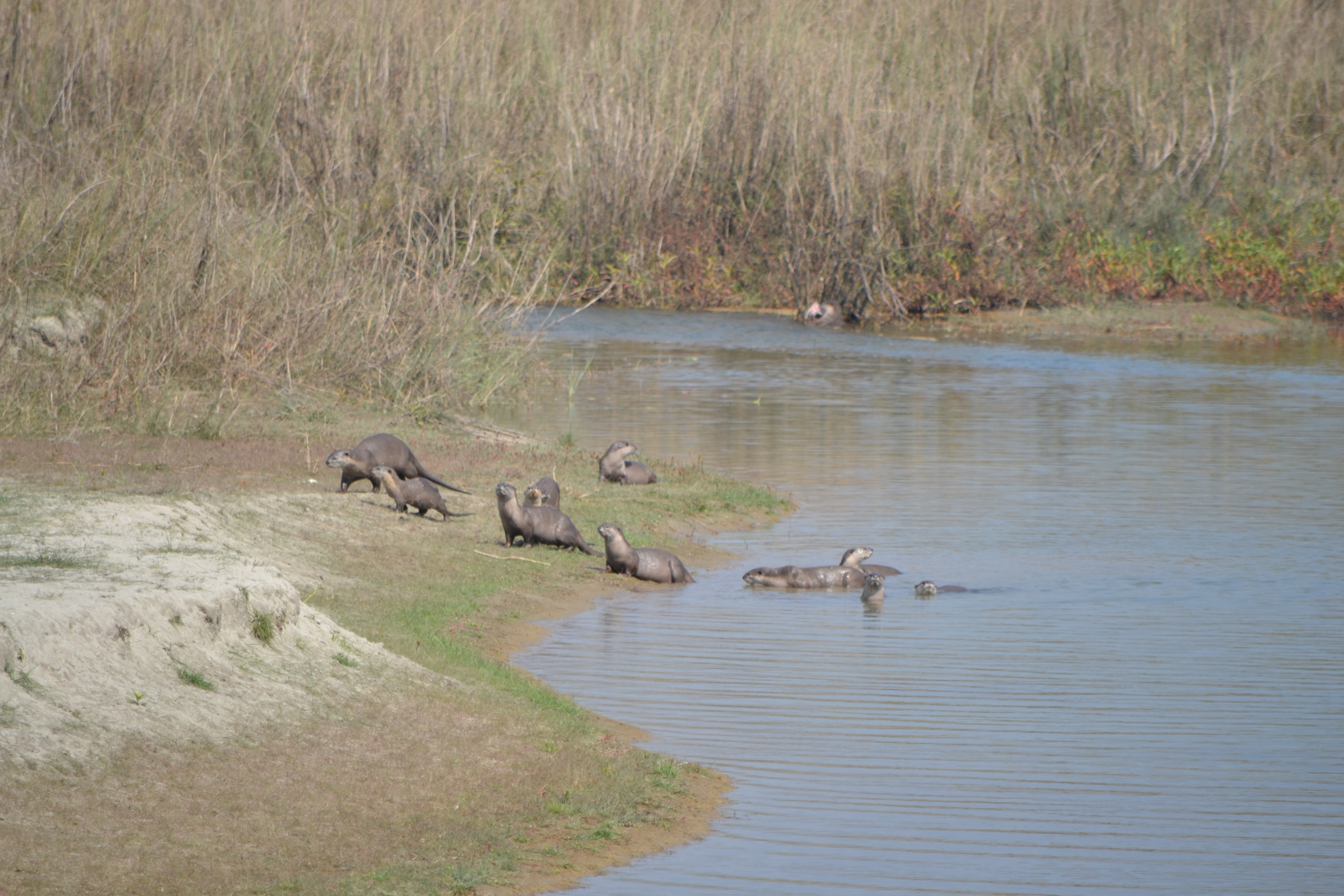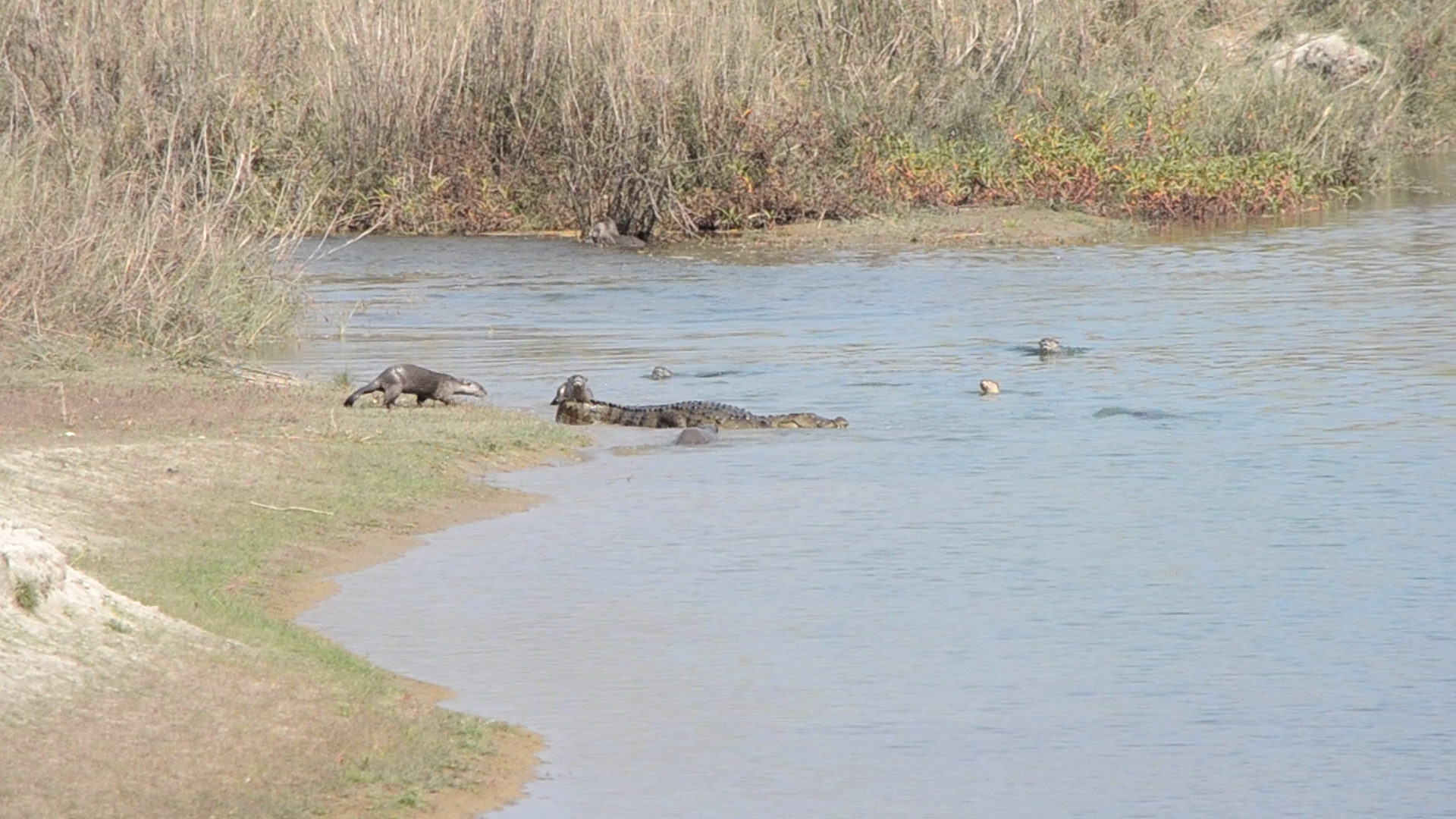IUCN/SSC Otter Specialist Group Bulletin

©IUCN/SCC Otter Specialist Group
Volume 37 Issue 2 (April 2020)
Citation: Bashyal, A and Yadav, BP (2020). Opportunistic Smooth-Coated Otter (Lutrogale perspicillata) Sightings Record in the Bardiya National Park of Nepal. IUCN Otter Spec. Group Bull. 37 (2): 120 -126
Opportunistic Smooth-Coated Otter (Lutrogale perspicillata) Sightings Record in the Bardiya National Park of Nepal
Ashish Bashyal1 and Bhupendra Prasad Yadav2
11Biodiversity Conservancy Nepal, Tilottama-6, Manigram, Rupandehi-32903, Nepal. Email:: a.bashyal@bioconnepal.org
2Department of National Parks and Wildlife Conservation, P O Box: 860, Kathmandu, Nepal
(Received 12th May 2019, accepted 11th November 2019)
Abstract: The Smooth-coated otter Lutrogale perspicillata is one among three species of otters found in Nepal. Although L. perspicillata has been classified as ‘Endangered’ nationally, there is a serious lack of information on various aspects of its natural history in Nepal including the Bardiya National Park (NP). We surveyed 118 km of the Karnali and Babai rivers from February 3-13, 2017 to record opportunistic sightings of L. perspicillata and its behaviour in the Bardiya NP. We directly sighted a total of 27 individuals of L. perspicillata including 14 in the Karnali and 13 in the Babai with relative densities of and 0.23/km in the Karnali and 0.22/km in Babai. Similarly, we also observed interspecific interaction between a large group of L. perspicillata and Mugger crocodile (Crocodylus palustris) in the eastern channel of the Karnali. The 46 km stretch of Babai and 30 km stretch of the Karnali river (eastern channel also referred to as Geruwa) within the jurisdiction of the core-protected area of the Bardiya NP has habitat only little modified and with relatively low anthropogenic disturbances owing to stringent protection level, and could be crucial to ensure long-term conservation of L. perspicillata in and around the Bardiya NP. Our findings establish a good preliminary baseline for L. perspicillata populations in the Bardiya NP and importantly for the Babai.Keywords: Otter, Karnali River, Babai River, Gharial, Mugger crocodile
INTRODUCTION
Nepal is home to three species of otter, the Eurasian otter Lutra lutra, the Asian small-clawed otter Aonyx cinereus and the Smooth-coated otter Lutrogale perspicillata (Kafle, 2009). The Smooth-coated otter (Figure 1) is classified as “Vulnerable” in the IUCN Red List and as an “Endangered” species in Nepal (Jnawali et al., 2011). Approximately 200-1000 L. perspicillata are estimated to occur in Nepal and its population is speculated to be declining (Kafle, 2009; Jnawali et al., 2011). The main threats to L. perspicillata and its habitat are believed to be habitat destruction and alteration including change in river morphology, poaching, entanglement and death in fishing nets and construction of dams (Kafle, 2009; Jnawali et al., 2011).

Although L. perspicillata is “Endangered” nationally, it is rather surprising that there is a serious lack of information on various aspects of its natural history in Nepal (Kafle, 2009; Acharya and Lamsal, 2010; Jnawali et al., 2011). In fact, throughout its range in Nepal, spatial distribution, population size, habitat preference etc. of L. perspicillata remain poorly understood as there have been few detailed studies on this species in the country (Kafle, 2009; Jnawali et al., 2011). The Government of Nepal, Department of National Parks and Wildlife Conservation has prepared action plans for major priority species but L. perspicillata is under shadow because to date there have been only limited scientific studies. Consequently, there is no action plan in place for L. perspicillata, thus further exacerbating its already perilous situation. Given the range-wide threats that L. perspicillata faces, stretches of rivers within the jurisdiction of protected areas could serve as a refuge to its dwindling populations. One such protected area which could be a critical refuge to L. perspicillata in Nepal is the Bardiya National Park (Bardiya NP; Figure 2). The Bardiya NP is drained by two perennial rivers (Karnali and Babai) which are home to gharial Gavialis gangeticus, Marsh crocodile Crocodylus palustris, Gangetic dolphin Platanista gangetica and L. perspicillata among others. Although some studies on L. perspicillata have been done in certain stretches of Karnali (Thapa, 2002; Bhandari, 2008; Joshi, 2009), there has been only one study (Bhandari, 2019) on this species in the Babai.
As a part of the Nepal Gharial Conservation Initiative, a long-term project aimed at safeguarding future of gharial populations in Nepal, we studied population and habitat ecology of gharials in the rivers of the Bardiya NP in 2017. During the course of this survey, we also recorded opportunistic sighting of L. perspicillata, its behaviour and interaction with Mugger crocodile throughout 118 km of Karnali and Babai rivers in the Babai of the Bardiya NP.
METHODS
Study Area
This study was conducted in sections of two rivers (Babai and Karnali) in Bardiya NP (28°15’ to 28°35.5’ N and 80°10’ to 81°45’ E; Figure 2). The Bardiya NP is situated in Bardiya district of Province-5 in south-western Nepal and covers an area of 968 square kilometers. The Bardiya NP is drained by two major rivers: the Karnali in the west and the Babai in the east (Bhuju et al., 2007). The Babai enters Bardiya NP from its north-eastern boundary and exits at Parewaodar approximately 46 km downstream. Similalry, the Karnali enters the Bardiya NP from its north-western boundary and bifurcates into two major channels downstream. A 60 kilometer (km) stretch of the Karnali River (comprising of 30 km strech within the protected area and 30 km stretch in the buffer zone) and a 58 km stretch of the Babai River (comprising of 46 km stretch in the protected area and 12 km in the buffer zone) were surveyed accordingly.

Opportunistic survey
From February 3-13, 2017, we surveyed a total of 118 km of the Karnali and Babai rivers. Surveys were conducted during day time (8:00 to 16:00 hour local time) by walking downstream along river banks. Occasionally, stationary surveys were also conducted from vantage points. River and banks were thoroughly searched for L. perspicillata on either bank with binoculars (Celestron Nature DX 8x42, Celestron, USA). Photographs of encountered L. perspicillata were taken with a Nikon 55-300 millimetre telephoto zoom lens attached to Nikon D3100 DSLR camera (Nikon Corporation, USA) and GPS (Global Positioning System) co-ordinates were recorded for each individual or a group of L. perspicillata using a hand-held GPS device (Garmin GPSmap64). Habitats where otters were encountered were classified into four categories (sand bank, clay bank, sand-grass bank and rocky bank) by modifying the classification scheme for gharial habitat in Narayani river of Nepal described by Maskey et al. (1995). Whenever possible, we observed L. perspicillata behaviour and interspecific interaction between L. perspicillata and other sympatric top predators.
RESULTS AND DISCUSSIONS
In a total of 118 km of the Karnali and Babai rivers, we directly sighted a total of 27 L. perspicillata (Table 1) of which 13 individuals in the Babai and 14 in the Karnali. We did not take any measure to eliminate/address possibility of repeat sightings of the same individual and it is possible that our total count might actually involve fewer than 27 individuals. We did not observe or suspect any other species of otter during our surveys. The relative densities of L. perspicillata were 0.22/km in Babai and 0.23/km in the Karnali. Lutrogale perspicillata was sighted in five different localities comprising two in the Babai and three in Karnali (Figure 2). The largest group of L. perspicillata which included 12 individuals was recorded in Teen kune where the animals were observed feeding and grooming on the sand bank. Two groups of otters comprising of 21 individuals were observed grooming whereas others were observed swimming (Table 1). Grooming behaviour was self-grooming which consisted of rolling on sandy bank with intermittent dips in water and drying by rolling (Hussain, 2013). This range of behaviour exhibited by otters probably is related to habitat type. For instance, two out of five groups that showed grooming behaviour were observed by the sand bank whereas the other three groups, that were swimming, were observed near rocky bank habitat.
Thapa (2002) estimated a density of 1 individual per km for L. perspicillata in a 35 km stretch of the Geruwa. Similarly, Bhandari (2008) estimated 40 L. perspicillata present in 1.98 square kilometres in the Karnali based on spraint count alone. Joshi (2009) studied the population of L. perspicillata in an unprotected stretch of the Karnali and suggested that indirect signs were mostly observed in undisturbed habitat, but their study did not provide any quantitative data on abundance or density of L. perspicillata signs. Similarly, Bhandari (2019) only mapped the potential distribution of L. perspicillata in 46 km stretch of the Babai based on the presence/absence of indirect signs but did not estimate its density. Since all of these studies including ours have adopted different methodologies to estimate L. perspicillata density/abundance, direct comparisons of estimates of L. perspicillata distribution might reflect as much about methodological differences as about real density differences.
Furthermore, all 27 L. perspicillata observed were within the jurisdiction of the Bardiya NP (classified as core protected area). None was observed in the 42 km of these rivers within the buffer zone which has less stringent protection level and much higher prevalence of threats than does the core protected area. Our observations indicate that major threats to L. perspicillata and its habitat appeared to be the destruction and modification of riverine habitats, sand mining, boulder quarrying and unlicensed fishing.
Smooth-coated otter is sympatric with the gharial and Mugger crocodile, two other top predators in the freshwater ecosystem of the Karnali and Babai rivers. We observed large group of L. perspicillata comprising of 12 individuals chasing around an adult Mugger crocodile in Teen kune (Figure 3). Teen kune is characterized by its sand bank and deep water pool and is seemingly preferred habitat by both of these species. We did not observe any interspecific interaction between L. perspicillata and gharials during the survey. Nonetheless, there seemed to be more signs of L. perspicillata such as foot track, tail drag marks and spraints in localities where gharials were seen than in localities where they were not, although this was not confirmed by systematic counting. Gharials are known to prefer sand banks for basking and deep water pools with higher fish abundance; and they feed primarily on fishes (Stevenson and Whitaker, 2010). The smooth-coated otter also feeds primarily on fish and prefers sandy banks for grooming activities (Hussain and Choudhury, 1998; Nawab and Hussain, 2012b). Such overlap in diet and behaviour suggests that probably there is some overlap in habitat preference and use in between otters and gharials. However, detailed study is warranted to clarify such speculation.

Herein, we presented our findings on opportunistic sightings of L. perspicillata in the Karnali and Babai rivers in the Bardiya NP. Although some prior information on L. perspicillata is available from Karnali, there had been no previous attempt to study relative abundance or density of L. perspicillata in the Babai. Our findings establish a good preliminary baseline for L. perspicillata populations in the Bardiya NP and importantly for the Babai. Our survey wasn’t primarily targeted at L. perspicillata and we did not take any measures to avoid repeated counting of the same individual. Nonetheless, our results could be compared to that of future studies with similar methodologies to approximately assess the change in density of L. perspicillata in the Karnali and Babai rivers in the Bardiya NP. The 46 km stretch of the Babai and 30 km stretch of the Karnali river (eastern channel also referred to as Geruwa) within the jurisdiction of the core-protected area of the Bardiya NP have very little anthropogenic disturbance and have habitat only little modified that holds L. perspicillata. It is therefore likely to be of particular importance for the species’ conservation in and around Bardiya NP. Long-term survival of L. perspicillata would benefit from the design and implementation of science-based conservation strategy based on information generated from scientific studies, which unfortunately are largely lacking for L. perspicillata in the Bardiya NP. It is urgent to conduct systematic survey to understand threats to L. perspicillata and their drivers so that strategies effective in their mitigation can be generated and implemented.
Acknowledgements: Data on Smooth-coated otter was collected during gharial survey which was funded by the Nagao Environmental Foundation (Japan) the Cleveland Metroparks Zoos and the Cleveland Zoological Society (USA) to A.B. We are grateful to the Department of National Parks and Wildlife Conservation (Permit: 1857-072/73 Eco-187), the Bardiya National Park (Permit: 1711-073/74), Ramesh Thapa, Ashok Bhandari and Rangi Lal Tharu, for their kind support. We thank Narayan Koirala and Shyam Sharma for editorial and GIS assistance. We also thank three anonymous reviewers for their feedback which greatly helped to improve our manuscript.
REFERENCES
Acharya, P., Lamsal, P. (2010). A survey for smooth coated otter Lutrogale perspicillata on the river Narayani, Chitwan National park, Nepal. Hystrix. 21(2): 199-202.
Bhandari, J. (2008). Status, distribution and major threats to otter in Bardiya National Park, Nepal. A bachelor research report submitted to IOF, Pokhara, Tribhuwan University.
Bhandari, J. (2019). Conservation Status Survey and Awareness of Smooth-Coated Otters in Babai River of Bardia National Park, Nepal. A final report submitted to Rufford Small Grants Foundation, UK.
Bhuju, U.R., Shakya, P.R., Basnet, T.B., Shrestha S. (2007). Nepal Biodiversity Resource Book: Protected Areas, Ramsar Sites, and World Heritage Sites. International Centre for Integrated Mountain Development, Ministry of Environment, Science and Technology, United Nations Environment Programme, Regional Office for Asia and the Pacific, Kathmandu, Kathmandu, Nepal.
Hussain, S.A., Choudhury, B.C. (1998). Feeding ecology of smooth-coated otter Lutra perspicillata in National Chambal Sanctuary. Proceedings of the Symposia of the Zoological Society of London, Behaviour and ecology of riparian mammals. 71: 229-250.
Husain, S.A. (2013). Activity pattern, behavioural activity and interspecific interactions of smooth-coated otter (Lutrogale perspicillata) in National Chambal Sanctuary, India. IUCN Otter Spec. group Bull. 30: 5-7.
Jnawali, S.R., Baral, H.S., Lee, S., Acharya, K.P., Upadhya, G.P., Pandey, M., Shrestha, R., Joshi, D., Lamichhane, B.R., Griffiths, J., Khatiwada, A.P., Subedi, N., Amin, R. (2011). The status of Nepal Mammals: The National Red List Series, Department of National Parks and Wildlife Conservation Kathmandu, Nepal. Preface by Simon M. Stuart IUCN Species Survival Commission, The Status of Nepal’s Mammals: The National Red List Series, 4. pp. 67-68, 88-89, 100.
Joshi, D. (2009). Status of Smooth Indian otter (Lutra perspicillata) and conservation of freshwater ecosystem outside protected areas of Bardiya National Park in Karnali River, Nepal. A report submitted to Rufford Small Grants Foundation, UK.
Kafle, G. (2009). A review on research and conservation of otters in Nepal. IUCN Otter Spec. group Bull. 26: 32-43.
Maskey, T.M., Percival, H.F., Abercrombie, C.L. (1995). Gharial habitat use in Nepal. J. Herpetol. 29: 464-468.
Nawab, A., Hussain, S.A. (2012b). Prey selection by smooth-coated otter (Lutrogale perspicillata) in response to the variation in fish abundance in Upper Gangetic Plains, India. Mammalia. 76: 57-65.
Stevenson, C., Whitaker, R. (2010). Indian Gharial Gavialis gangeticus. pp. 94-98 In Crocodiles: Status Survey and Conservation Action Plan. 3rd Edition. In Manolis, S.C. & Stevenson, C. (Eds). Crocodile Specialist Group, Darwin, Australia.
Thapa, T.B. (2002). Survey of smooth coated otter Lutrogale perspicillata in Karnali river of Royal Bardiya National Park Nepal. A research report submitted to IOSF, UK.
Resume: Registre des Observations Opportunistes de la Loutre à Pelage Lisse (Lutrogale Perspicillata) dans le Parc National du Bardiya au Népal
La loutre à pelage lisse Lutrogale perspicillata est l'une des trois espèces de loutres présentes au Népal. Bien que L. perspicillata ait été classée comme «en voie de disparition» à l’échelle nationale, il existe un sérieux manque d’informations sur divers aspects de son histoire naturelle au Népal, en ce compris le parc national de Bardiya (NP). Nous avons inspecté 118 km des rivières Karnali et Babai du 3 au 13 février 2017 pour enregistrer des observations opportunistes de L. perspicillata et son comportement dans le PN de Bardiya. Nous avons directement observé un total de 27 individus de L. perspicillata dont 14 dans le Karnali et 13 dans le Babai avec des densités relatives de 0,23 / km dans le Karnali et 0,22 / km dans le Babai. De même, nous avons également observé une interaction interspécifique entre un grand groupe de L. perspicillata et le crocodile de Mugger (Crocodylus palustris) dans le canal oriental du Karnali. Les tronçons rivière de 46 km du Babai et de 30 km du Karnali (canal oriental également appelé Geruwa) situés dans la juridiction de l'aire protégée centrale du PN de Bardiya ont un habitat peu modifié avec des perturbations anthropiques relativement faibles en raison du niveau de protection rigoureux. Ils pourraient être cruciaux pour assurer la conservation à long terme de L. perspicillata dans et autour du PN de Bardiya. Nos résultats établissent une bonne base de référence préliminaire pour les populations de L. perspicillata dans le PN de Bardiya et surtout pour le Babai.
Revenez au dessus
Resumen: Registro de Avistajes Oportunísticos de Nutria Lisa (Lutrogale perspicillata) en el Parque Nacional Bardiya, Nepal
La nutria lisa Lutrogale perspicillata es una de las tres especies de nutria de Nepal. Aunque L. perspicillata ha sido clasificada nacionalmente como “En Peligro de Extinción”, hay una seria falta de información sobre varios aspectos de su historia natural en Nepal, incluyendo al Parque Nacional (PN) Bardiya. Relevamos 118 km de los ríos Karnali y Babai, entre el 3 y el 13 de Febrero de 2017, para registrar avistajes oportunísticos de L. persicillata, y su comportamiento, en el PN Bardiya. Avistamos en forma direta un total de 27 individuos de L. perspicillata, incluyendo 14 en karnali y 13 en Babai, con densidades rrelativas de 0.23/km en Karnali y 0.22/km en Babi. En forma similar, también observamos interacciones interespecíicas entre un gran grupo de L. perspicillata y un cocodrilo de las marismas (Crocodylus palustris) en el canal oriental del Karnali. Los 46 km del río Babi y los 30 km del río Karnali (el canal oriental también conocido como Geruwa) dentro de la jurisdicción del área protegida núcleo del PN Bardiya, tiene hábitat modificado sólo ligeramente, y con disturbios antrópicos relativamente bajos, debido al estricto nivel de protección, y podrían ser cruciales para segurar la conservación a largo plazo de L. perspicillata en y alrededor del PN Bardiya. Nuestros hallazgos establecen una buena línea de base preliminar de las poblaciones de L. perspicillata en el PN Bardiya, y de manera importante para el Babai.
Vuelva a la tapa

